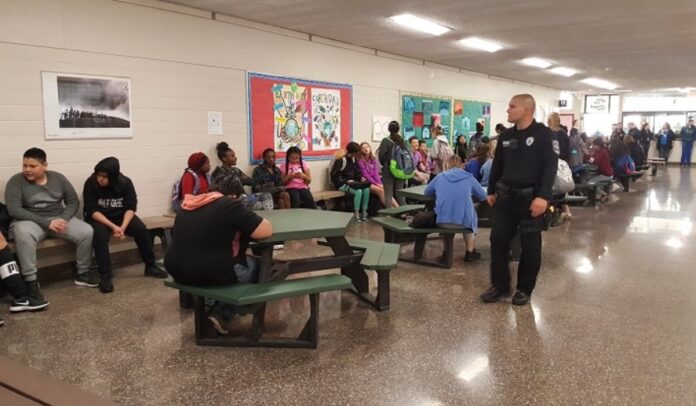 To the editor:
To the editor:
“Those mass shootings — where should we start to protect our schools?”
A California school district administrator posed that question to me face-to-face years back, while I examined other control-of-risk factors with the district. They were rightly concerned, in light of several terror attacks that occurred in U.S. schools at the time.
My response to the administrator contained a question: “What are you doing to secure each point of access to your building?” The chilling answer: “Nothing.” I suggested that the school start there, knowing that so many attacks result from walk-in terrorists facing few if any barriers, minimal security and, in some cases, no questions.
This recent catastrophic rampage in Perry in the first week of 2024 savagely took the life of a middle school youth and just claimed the school principal. The shock cascades outside Iowa, our home state. My wife grew up near this community of just under 8,000 people.
Criminal cowards who do the unthinkable are often singular, deranged types, claiming vengeance, seeking notoriety — and often their self-directed ending. These perpetrators could have been stopped decades ago with proven security, which we will explore here.
School casualties continue
In the pure life-or-death matter of saving our greatest resources, the children, lawmakers could have responded to school massacres in critical mode. That is, they could have responded with the same vigor as in other catastrophes. Authorities would hammer out solutions, and we would already be at or near zero school casualties from murderous intruders.
Authorities should have driven toward zero casualties in our education system with the same motivation as the ramp up after the bombing of Pearl Harbor or — in tamer terms — our race to the moon. They haven’t. It’s reasonable to ask, Why? since there appears to be no discernible priority to stop school carnage. Hence, this is a war inside the U.S.. against unarmed innocents in our schools, raging on with no predicable end.
To protect soft targets like schools with definitive controls, it’s past time for a tactic that works. Begin with the fortresses in Washington, D.C., which house the country’s most concentrated population of attorneys, our lawmakers. Let’s not be distracted by Jan. 6, 2021. It happened. It’s an anomaly. It did not involve mass shooting and is a separate discussion. Let’s keep our focus on the objective: protecting vulnerable school youth and staff.
The answer to stopping school intruders lies in Washington
Start where logic directs us. How many lawmakers have been victims in mass shootings inside our nation’s Capitol buildings? How many such incidents have there been in the last 50 years or 100 years? Historically, there were scattered incidents of some frequency involving internal assaults, fist fights and caning, but most lawmaker-against-lawmaker violence occurred before and during time of the U.S. Civil War. Single bombings in 1915, 1971 and 1983 caused extensive damage to the U.S. Capitol but no injuries.
In our history since the mid-20th century, two shooting incidents occurred within approximately the past 70 years. One involved a Puerto Rican group that rushed into the U.S. House of Representatives in 1954, firing at and injuring five members of Congress. The last such incident occurred in 1998, when a shooter fired upon and killed two Capitol Police Officers.
Any fatal shooting is a senseless tragedy. The last one spurred bolstered security in Washington, D.C., for U.S. lawmakers. Solidified access control with armed officers and checkpoints created a safer space. For that large area totaling over 1.5 million square feet, the upgraded security and safety of lawmakers show the methods are effective.
Mass shootings of lawmakers inside secure buildings are no longer likely. As such, the lesson is clear for educational systems. If security upgrades satisfy politicians, then it should work for school children. In any case, and no matter one’s political leanings, it is crucial to pursue a different path for school security than the current failed ones.
Various school security solutions have been tried, some successfully. In this review, we will focus on one solution, a resolve for improved school hardware and control of all access points. In effect, hardening our school buildings is key to increased security. Firearms aren’t the focus here, though that functional hardware is likely factored into improved security for many critical applications, particularly if law enforcement or armed security is assigned to schools. Firearms are not disparaged here, as clarified by President Joe Biden himself.
President Biden’s early observations on firearms and crime were recorded decades ago when he was a Senator, during a 1985 debate on the Firearms Owners’ Protection Act to amend the Gun Control Act of 1968. Then Sen. Biden said then, “During my 12.5 years as a member of this body, I have never believed that additional gun control or Federal registration of guns would reduce crime. I am convinced that a criminal who wants a firearm can get one through illegal, nontraceable, unregistered sources, with or without gun control.”
Thus there is logic to the premise of keeping criminals out of the building, rather than attempting control of an endless supply of miscreants’ destructive tools, be it firearms, knives, machetes, bats, tire irons, even liquid propane gas—the majority of which are available at local hardware and sporting goods stores nationwide.
Hardening structures against unwanted access is the objective, so less talk and more action is the logical next step. Getting anchored to an endless, emotive debate about whether firearms should be part of top-flight security systems is already settled. Both sides of the political spectrum appear to be very comfortable with firearms’ role in their own security at the U.S. Capitol. Could that security knowledge be useful elsewhere? Absolutely!
Hardening schools
It makes sense in securing schools to concentrate on the most effective security used by our lawmakers. The focus must be on what works now, not on promises and failed systems.
School hardening has been explored historically by:
1. Securing all openings, electronically monitoring them and controlling one access point, with armed security monitors.
2. Rejecting the hardening idea out of hand, citing ideologies, often by administrators and educators themselves, against creating what they call “prison-like complexes.”
3. Setting aside the whole security idea and keeping the status quo due to budget restraints.
Comparing security for our politicians vs. school students prompts the question: Why are protections for the two groups not similar or even identical? Differences in security between schools and lawmakers’ offices are shocking. As such, lawmakers enjoy high-level comfort and safety, while school children rightly sense fear and wonder about when the next shoe will come crashing down in their somewhat porous environments.
In educational institutions across the nation, thousands of buildings remain static, with little or no improved security. For the few claiming they are secure, educators decry teachers who compromise secured exterior doors — the “just for a moment while I go for something in my car” excuse — potentially allowing a brief but deadly opportunity for compromised entry: a blocked-open door. Where buildings are freely accessed, risk potential for catastrophic loss of life is dangerously elevated.
In discussing this volatile matter with law enforcement, their concern about unsecured school buildings also centers on students who—for various reasons—allow a buddy into the building through an unmonitored, unsecured door. Why haven’t districts everywhere provided alarmed panic hardware that would serve as deterrents to a rebel who opens an outside door for someone to gain school access? Law enforcement personnel I spoke to say unsecured doors need immediate attention and buttoning up. Security hardware for such doors has gained approval by seasoned fire department life safety inspectors.
In conversations with educators, construction professionals, security, safety, law enforcement and lawmakers, similar responses were fielded. Common issues cited come down to costs, school boards’ reluctance to boost security, teachers’ unwillingness to teach in a secure (their term: policelike) atmosphere, and in Minnesota, school resource officer (SRO) issues. Some of those interviewed expressed concern about being quoted because of today’s free-speech firestorms, so none were cited. The irony of such fear is lost on no one.
Educators cited teachers’ hesitance over increased security, such as improved access control and classroom camera monitors. Teachers do not like these intrusions, we are told. History shows we must step beyond illogic to solve today’s issues to protect the children.
Sacrificing feelings and emotions, we could gain powerful protection for school children and staff. Think of the protection provided for public officials. Injecting their security provisions into school upgrades would literally and figuratively slam the doors on evil malcontents.
Dialogue with diverse professionals yielded a universal passion for bolstering school security. All agree with solidifying physical buildings and access. Notably, professionals also agreed on decisionmakers’ reluctance to bolster security and student safety, and a failure to act with meaningful follow through. Firearms were rarely mentioned, despite the reality of an unspecified percentage of trained, armed educators that are now in place in some states, successfully so.
School Resource Officer concerns
In 2023 Minnesota lawmakers inexplicably tightened restrictions on SROs’ use of force against students. They did so despite the widely popular, positive influences of the SRO program. SROs gained popularity during the first nine years of existence. Their objectives: develop positive student relationships, defuse tensions, be mentors, control crime and teach classes.
State legislators updated the SRO law, with no evidence of excessive force by officers in any school. Lawmakers failed to contact a single police force representative to seek expert input from SROs who love what they do. Was tightening the law needed? Lawmakers’ efforts appeared to hinge on an ulterior fear motive, from fresh memories of metro riots and conflagrations after the 2020 police murder of George Floyd in Minneapolis.
Concern over potential consequences of tightening legislation caused law enforcement agencies to pull their people from some Minnesota schools. They cited liability over possible SRO violations of a questionable law. SRO withdrawal actions then prompted the Minnesota Attorney General to weigh in on the newly adopted legislation, in an attempt to quell concerns. The AG’s opinion was not convincing, and confusion over the updated law remains. Hence, a warning: do not let a misguided Minnesota law serve as a guide to cripple Iowa’s successful SRO program.
Signs are unworkable
Signs as security tools cannot work. Look no further than a near-universal push for signage at our schools: “Firearms Are Banned on These Premises.” Signs are every bit as effective as Orders of Protection to shield innocent domestic partners from the deranged who deal in bodily harm. In the eerily similar cases of perpetrators going off their lucid rails, signs and orders simply target victims. Law enforcement knows this. Parents and survivors are all too clear about the problem. Don’t school administrators, school legal advisors, school boards, prosecutors and judges know? This is the very heart of our quagmire: They do know!
Criminal illiteracy is not the problem in outrageous, failed attempts at protection through signs. Rather, the criminals’ intent to pursue lawlessness is the issue—and for an invaded school, failure to stop misfits before they get inside the building massively contributes to catastrophic loss of life.
Misplaced priorities
To understand this battle to improve school security, follow the money. Two illustrations strike boldly, with ironic form. In one example, a retired Minnesota brick mason visited his grandchild’s soccer game recently. The small school in central Minnesota sports a beautiful masonry structure as an entrance to the playing field. The brick monolith serves no visible or redeeming purpose other than to reinforce someone’s ego. He estimated the cost: $750,000. This is no security element; it is waste.
In the other example of security vs. sport, remarkable harbingers of poor priorities are exemplified in high schools. Three standouts are from Texas (McKinney, Katy and Allen). Their excess was publicized on Fox Sports in 2017. Astoundingly, multimillion-dollar stadiums were built, ranging from $60 million to $62.8 million. At what price, security? We don’t know the security budgets for these institutions. But just imagine the security upgrades that could be implemented if at least 5% of the stadium budgets were diverted to improving student and staff protection.
Continuing forward, ask any competent architect specializing in institutional design where they would start to improve school design for protecting students and staff. Established veteran designers won’t default to signs. They will focus on physical building improvements to protect people inside it.
Bolstering educational security should start with legislators — local, state and federal — and school boards and businesses to express concern for school security and safety. Publicize the issues with parents in the school system. The action taken today is a small step toward tomorrow’s results. There are no illusions about what we can accomplish and when. It is a long-term commitment of time, perseverance and vigilance. Nobel prize winner Marie Curie had this to say about persistence, “I was taught the way of progress is neither swift nor easy.”
Today, we see an insane dichotomy: we will send astronauts to the moon and safely return them in a nearly half-million-mile round trip of immense complexity. Then we send our children to unsecured schools where there is a risk of losing their lives just a few miles from home, inside a building with adults that should protect them. Neither can, and few do. So the mortality continues.
Simple solutions are at hand. Politicians tolerate highly secure buildings with a law-enforcement atmosphere but don’t complain, so why not tap similar essentials of their environment for schools? School children could live with that, same as our valued lawmakers already do.
We must ask authorities questions about improved security they might not want to answer, and figuratively hold their collective feet to the flame. Wait for answers, direct and on-point. If they cannot answer, then voting can be a prescriptive measure to cure bipartisan inaction. These are legal, reasonable inroads to boosting school security for the long term.
Local schools approached by the well-intended, security-minded parents to enable action on improved protection may be bogged down quickly in bureaucracy. Parents could be confronted with bona fide reasons why no immediate action is likely for tightening security.
Lack of money is one reason. When we look at the luxurious expenditures on school sports and other electives, it is clear that reasons appear to evolve into excuses for insufficient security. In that light, increased taxes for the school district must not be a prime pursuit.
If school district budgets have no room for emergencies, security or unexpected expenses, then the schools’ money managers are not exercising due diligence. That includes cutting unnecessary spending. If queries about improving protection are unsuccessful, then a track-proven, money management professional can be hired to replace the ineffective one who should be fired. Persistence is vital, for survivors are keenly aware of our actions, broadcasting to the world what we value the most.
School students and staff tenuously watch and wait for our answers.
Lee J. Huber of Elk River, Minnesota, is a board-certified professional ergonomist. He was raised in Iowa and is an Iowa State University graduate. He has worked for national defense contractors, international food producers and processors, major airlines and manufacturing companies. Huber has more than 40 years’ experience in safety, ergonomics and security as a problem-solver, consultant, expert witness and educator in these disciplines.


















Better, cheaper solution, get rid of the guns.
“…an endless supply of miscreants’ destructive tools, be it firearms, knives, machetes, bats, tire irons, even liquid propane gas…”
They drag out that old canard, in one form or another, year after year, decade after decade.
One of these things is not like the others.
The Second Amendment doesn’t mention the word gun.